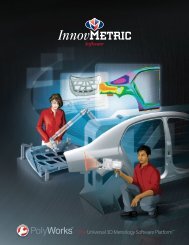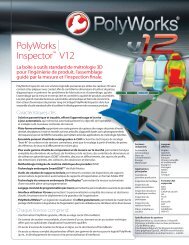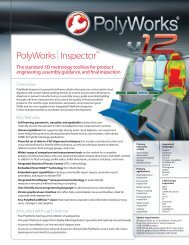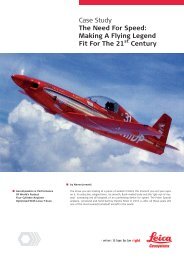PolyWorks Case Study - CFD Analysis.pdf - Innovmetric Software
PolyWorks Case Study - CFD Analysis.pdf - Innovmetric Software
PolyWorks Case Study - CFD Analysis.pdf - Innovmetric Software
You also want an ePaper? Increase the reach of your titles
YUMPU automatically turns print PDFs into web optimized ePapers that Google loves.
3. Reduce the number of triangles and optimize triangle orientation<br />
<strong>PolyWorks</strong> adaptive meshing technology enables the creation of “intelligent” polygonal models,<br />
preserving high resolution over edges and fillets while creating larger triangles in flat areas. To<br />
comply with Exa PowerFlow’s strict requirements, a polygonal model should:<br />
• Contain around 100,000 triangles<br />
• Not contain any triangles with bad aspect ratios (height/base)<br />
• Have triangles whose orientation follows the curvature of the object.<br />
<strong>PolyWorks</strong> offers advanced techniques to prepare a model that meets these requirements.<br />
Users can:<br />
• Set the reduction parameter as a target number of triangles.<br />
• Use a maximum edge length to prevent the creation of large triangles with poor aspect ratios.<br />
• Specify the edge detection angle for preserving feature lines.<br />
• Invoke a mesh optimization algorithm that aligns the triangle edges along the curvature flow.<br />
Edited model of 1,000,000 triangles<br />
before reduction and optimization.<br />
100,000-triangle model with triangle<br />
orientation following the curvature of<br />
the object<br />
Raise the <strong>CFD</strong> <strong>Analysis</strong> to Another Level with <strong>PolyWorks</strong><br />
Finally, an optimal polygonal model is exported by <strong>PolyWorks</strong> as an STL file to Exa’s PowerFlow<br />
for thorough <strong>CFD</strong> simulation. PowerFlow transforms the polygonal model into a mesh of Voxels<br />
to describe the solid surface, and calculates how particles are allowed to move and collide with<br />
each other and with the solid surface over a real-time period. A PowerFlow <strong>CFD</strong> analysis empowered<br />
by <strong>PolyWorks</strong> offers a series of benefits simply not achievable with physical wind tunnel<br />
simulations, and gives specialists of the automotive industry unprecedented insight into<br />
fluid flow behavior.<br />
Benefits from using <strong>PolyWorks</strong> to optimize <strong>CFD</strong> analysis:<br />
Minimizes the time for model preparation, which frees<br />
more time to better analyze results<br />
Provides more information during conceptual design<br />
Opens the doors to faster product development<br />
Brings superior quality products to market<br />
Generates major cost savings<br />
Model courtesy of<br />
Ford Motor Company<br />
For more information on this article please contact Sacha Villeneuve at svilleneuve@innovmetric.com<br />
<strong>PolyWorks</strong> is a registered trademark of InnovMetric <strong>Software</strong> Inc. PowerFlow is a registered trademark of<br />
Exa Corporation Inc. All other trademarks are property of their respective owners. www.innovmetric.com











